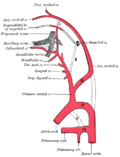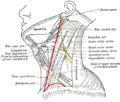This article includes a list of references, related reading, or external links, but its sources remain unclear because it lacks inline citations .(May 2015) |
| Facial artery | |
|---|---|
 The arteries of the face and scalp. (External maxillary visible at bottom center.) | |
 Outline of side of face, showing chief surface markings. (Label for "Ext. Max. Art." at bottom left.) | |
| Details | |
| Source | External carotid artery |
| Branches | Ascending palatine artery tonsillar branch submental artery glandular branches inferior labial artery superior labial artery lateral nasal branch angular artery (terminal branch) |
| Vein | Anterior facial vein, posterior facial vein |
| Identifiers | |
| Latin | arteria facialis, arteria maxillaris externa |
| TA98 | A12.2.05.020 |
| TA2 | 4388 |
| FMA | 49549 |
| Anatomical terminology | |
The facial artery, formerly called the external maxillary artery, is a branch of the external carotid artery that supplies blood to superficial structures of the medial regions of the face.



